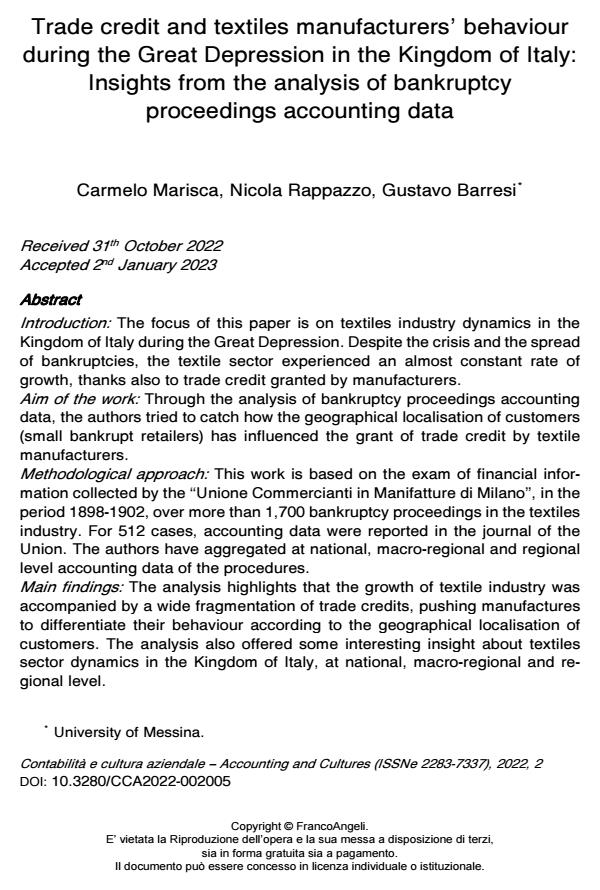Trade credit and textiles manufacturers’ behaviour during the Great Depression in the Kingdom of Italy: Insights from the analysis of bankruptcy proceedings accounting data
Titolo Rivista CONTABILITÀ E CULTURA AZIENDALE
Autori/Curatori Carmelo Marisca, Nicola Rappazzo, Gustavo Barresi
Anno di pubblicazione 2023 Fascicolo 2022/2
Lingua Inglese Numero pagine 23 P. 91-113 Dimensione file 511 KB
DOI 10.3280/CCA2022-002005
Il DOI è il codice a barre della proprietà intellettuale: per saperne di più
clicca qui
Qui sotto puoi vedere in anteprima la prima pagina di questo articolo.
Se questo articolo ti interessa, lo puoi acquistare (e scaricare in formato pdf) seguendo le facili indicazioni per acquistare il download credit. Acquista Download Credits per scaricare questo Articolo in formato PDF

FrancoAngeli è membro della Publishers International Linking Association, Inc (PILA)associazione indipendente e non profit per facilitare (attraverso i servizi tecnologici implementati da CrossRef.org) l’accesso degli studiosi ai contenuti digitali nelle pubblicazioni professionali e scientifiche
Introduction: The focus of this paper is on textiles industry dynamics in the King-dom of Italy during the Great Depression. Despite the crisis and the spread of bankruptcies, the textile sector experienced an almost constant rate of growth, thanks also to trade credit granted by manufacturers. Aim of the work: Through the analysis of bankruptcy proceedings accounting data, the authors tried to catch how the geographical localisation of customers (small bankrupt retailers) has influenced the grant of trade credit by textile manufacturers. Methodological approach: This work is based on the exam of financial information collected by the "Unione Commercianti in Manifatture di Milano", in the period 1898-1902, over more than 1,700 bankruptcy proceedings in the textiles industry. For 512 cases, accounting data were reported in the journal of the Union. The au-thors have aggregated at national, macro-regional and regional level accounting data of the procedures. Main findings: The analysis highlights that the growth of textile industry was ac-companied by a wide fragmentation of trade credits, pushing manufactures to dif-ferentiate their behaviour according to the geographical localisation of customers. The analysis also offered some interesting insight about textiles sector dynamics in the Kingdom of Italy, at national, macro-regional and regional level. Originality: The paper permits to enlarge the understanding of textile industry dy-namics during the Great Depression, adopting an approach overlooked in litera-ture.
Parole chiave:textile industry, Kingdom of Italy, bankruptcy procedures, accounting analysis, trade credit
- Italian accounting history studies in international journals: Insights and possible future directions Nicola Rappazzo, Carmelo Marisca, Luisa Pulejo, in Accounting History /2023 pp.490
DOI: 10.1177/10323732231179509 - A historical comparison exactly one hundred years apart. The global financial crises of 1907 and 2007 and the FIAT case study Stefano Garzella, Rosita Capurro, Stefano Marciano, in CONTABILITÀ E CULTURA AZIENDALE 1/2024 pp.43
DOI: 10.3280/CCA2024-001003
Carmelo Marisca, Nicola Rappazzo, Gustavo Barresi, Trade credit and textiles manufacturers’ behaviour during the Great Depression in the Kingdom of Italy: Insights from the analysis of bankruptcy proceedings accounting data in "CONTABILITÀ E CULTURA AZIENDALE" 2/2022, pp 91-113, DOI: 10.3280/CCA2022-002005